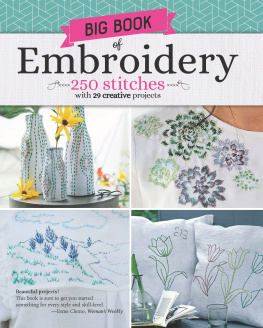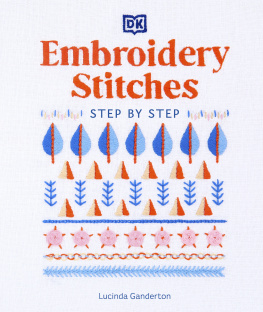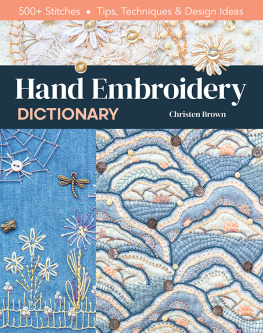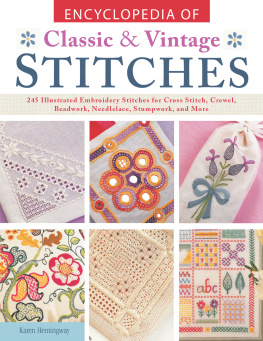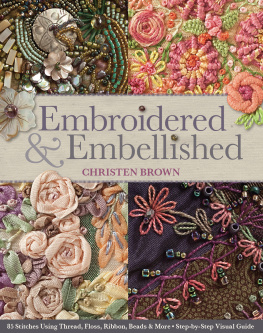The Complete Photo Guide to
NEEDLEWORK



Copyright 2012, 2011 Creative Publishing international, Inc.
Project designs, illustrations, and stitch graphs 2012 Linda
Wyszynski
Photography 2012 Creative Publishing international, Inc.
All rights reserved. No part of this work covered by the
copyrights hereon may be reproduced or used in any form or
by any meansgraphic, electronic, or mechanical, including
photocopying, recording, taping of information on storage
and retrieval systemswithout the written permission of
the publisher. The publisher grants to the purchaser of this
book permission to copy the project patterns for personal use.
Due to differing conditions, materials, and skill levels, the
publisher and various manufacturers disclaim any liability for
unsatisfactory results or injury due to improper use of tools,
materials, or information in this publication.
First published in the United States of America by
Creative Publishing international, Inc., a member of
Quayside Publishing Group
400 First Avenue North
Suite 300
Minneapolis, MN 55401
1-800-328-3895
www.creativepub.com or www.Qbookshop.com
Visit www.Craftside.Typepad.com for a behind-the-scenes
peek at our crafty world!
ISBN: 978-1-58923-641-7
Printed in China
10 9 8 7 6 5 4 3 2 1
Digital Edition: 978-1-61058-176-9
Softcover Edition: 978-1-58923-641-7
Library of Congress Cataloging-in-Publication Data
Wyszynski, Linda.
The complete photo guide to needlework / Linda Wyszynski.
p. cm.
ISBN-13: 978-1-58923-641-7 (pbk.)
ISBN-10: 1-58923-641-6 (soft cover)
1. Embroidery-Pictorial works. 2. Needlework-Pictorial works. I. Title.
TT770.W97 2012
746.44-dc23
2011023809
Copy Editor: Catherine Broberg
Proofreader: Karen Ruth
Cover and Book Design: Kim Winscher
Photo Coordinator: Joanne Wawra
Page Layout: Heather Parlato
Illustrations, graphs, and stitch photographs: Dennis Wyszynski
CONTENTS
Introduction

This book will open the door to the world of needlework for you. There are always new threads, beads, and fabrics available that are saying come explore with me. Discover all the wonderful ways you can enjoy creating with stitches. Once you learn the stitches, anything is possible. Beautiful fabrics and threads are just waiting for you to pick them up and create.
There are no dos or donts in todays world of needlework. The ABCs will describe the equipment available, how to transfer designs, and how to start creating designs of your very own. You will find descriptions of different types of supplies that are available today. It is up to you to decide what you want to purchase. Some stitchers become collectors of tools, while others are attracted to threads, embellishments, or fabrics. You may be the stitcher who only purchases what is needed to complete the project at hand and then discover your weakness along the way. Ive never found my single weakness, I love it all.
At the beginning of each technique chapter, different types of fabric are discussed that are suitable for that technique. Once you learn the basic skills outlined in each chapter, youll be able to create any of the stitches found within those pages. A full-size photograph and a stitch graph will show in clear steps how the needle is to travel. The projects are simple enough for a novice to enjoy, yet intriguing enough to entice the advanced stitcher.
In many of the technique chapters, I often say keep the stitch straight or use the same height for each stitch. While this is important to follow if possible, its also essential that you as the stitcher enjoy stitching. When my grandmother taught me to stitch when I was eight, it was important to her that each stitch be worked the best it could be. I was to remove the stitch and rework it if it wasnt perfect. Over the years Ive triedwithout successto eliminate that reminder from my brain. Even today I hear Grandmother Coggins saying it could be a little straighter or the loops need to be the same height. Thanks to her I am able to create stitching works of art. But what your eye and hand create is a work of art each time you pick up a needle and threadwhether or not it is perfect. Stitch for relaxation and have fun doing it!
I have given you the information needed to become a needle artist. As you look over the projects, think about how you, as the stitcher, can complete a project as shown or be adventuresome and take my challenge. The challenge is to use the ideas given but choose your own stitches, fabric, threads, and embellishments. Use the stitch guide sections as a resource when choosing new stitches or surfaces for the projects. Use whatever fabric, thread, or embellishment you fancy. The choice is yours to make.
Get started by taking a shopping trip, and you will see the gorgeous colors of threads and fabrics along with the various tools that are available today. You only need a few basic supplies to create your first project. The world of needlework is waiting for you to create whatever your imagination can conceive. Create a project using one or multiple techniques shown in this book. The ideas that come to mind are endlessfrom home dcor to embellished jeans to jeweled cuffs. You are in the drivers seat for one of the wildest creative journeys of your life.

ABCs OF NEEDLEWORK

All you need to get started is a needle, thread, fabric, pair of scissors, and an idea. The correct equipment enhances the needlework experience and makes stitching much easier. The information in this section will be used as a reference for choosing the correct equipment and supplies. You will refer to the information time and time again.
Stitching Equipment and Supplies
Needlework requires a very low investment in equipment and supplies, yet there are many options to consider. Many tools, fabrics, threads, and yarns can be used for more than one type of needlework, and those items are introduced here. Specific information is provided in each needlework section.
NEEDLES
Needles are the most important tool required to create a beautiful piece of needlework. The type and size of needle you choose depends on the fabric or canvas and the type of thread or wool to be used for the stitching.
A needle needs to fit your hand and feel comfortable when stitching. Choose a needle with an eye large enough for the thread or wool to move freely through but not larger than needed. This is especially true when working with silk ribbon which will become tangled and difficult to work with if the eye is not large enough.
When you stitch, the threads of the fabric move, allowing the needle to slide through the weave. Once the needle passes through, those threads move back into place. But when you work with a needle that is too large, it leaves a hole in the fabric or enlarges the canvas hole.
Next page


